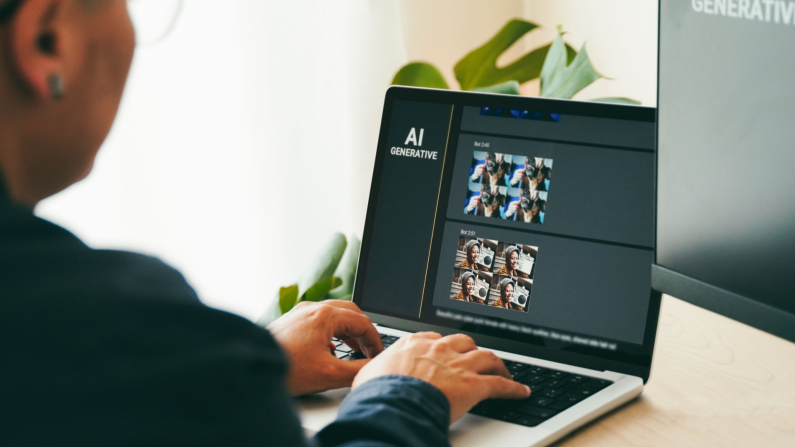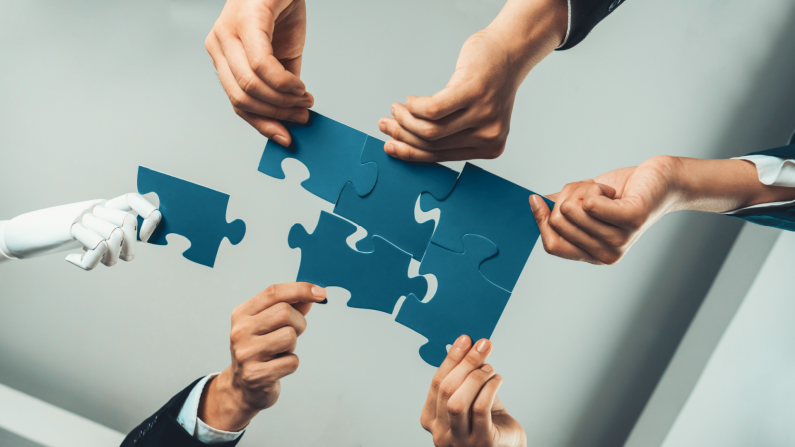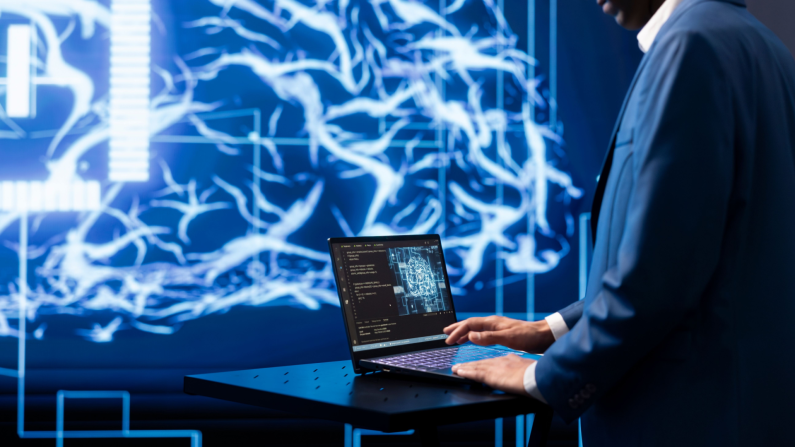A recent study has proven that artificial intelligence is no longer perceived as a revolutionary innovation or a novelty. Neural networks have long become a part of everyday life.
Moreover, we are standing on the threshold of a new era — one in which not only routine tasks are automated, but the very concept of labor is being transformed; machines are becoming not just auxiliary tools, but active players on the corporate stage.
In this article, we will explore how AI affects employment and the distribution of roles within companies, what new professions are emerging thanks to AI technologies, and what it means for humans to live and work in the age of advanced technologies.
How AI Affects Employment and Role Distribution in Companies

Automation technologies and AI are gradually ceasing to be part of a futuristic narrative and are becoming integral to the way work is organized today. According to a report by the Organisation for Economic Co-operation and Development, companies implementing AI tend to be large, successful firms — and it is precisely these companies that most often reshape the distribution of roles within their organizations.
Redistribution of Roles
When AI systems take over tasks previously performed by humans — for example, processing applications or “smart” analytics — a shift in roles occurs:
-
Some employees gain the opportunity to move toward tasks of higher abstraction: supervision, interpretation, and decision-making.
-
Others, on the contrary, come under pressure if their tasks are easily formalized and transferable to machines. For example, administrative personnel — those performing servicing functions and regularly repeated processes.
In small and medium-sized businesses, the role of AI remains limited: they tend to use these technologies as tools rather than as transformative factors. As a result, the gap between “digital transformation leaders” and others creates new inequalities.
Statistics and Outlook
According to an American study, about 30% of current jobs could be automated by 2030, and around 60% more are expected to undergo significant changes in the nature of tasks. In Europe, roughly a quarter of employees already report using AI tools in their work (among those aged 18–34, this figure reaches 36%). It is important to note, however, that the implementation of AI does not necessarily lead to mass layoffs — rather, it brings about redistribution.
Implications for Companies
For businesses, the transformation of roles means:
-
Rethinking staff structure: fewer people for tasks that can be algorithmized, more for those related to the creation and maintenance of AI systems.
-
Growing demand for employees who can work effectively with AI — not just confident users, but those able to interact intelligently with machines and collaborate productively.
-
The emergence of new verticals within HR, analytics, and creative departments.
-
Intensified competition for talent possessing skills that complement AI — and, simultaneously, the risk of being left behind for those who fail to adapt.
New Professions Emerging Thanks to Artificial Intelligence

With the rapid development of AI tools, it is becoming clear that alongside the disappearance of certain professions, new and sometimes entirely unexpected roles are emerging. For example:
AI Ethics Auditor
Machine learning and generative AI systems are increasingly used in business, but they bring risks — from algorithmic bias to data misinterpretation. The profession of an “AI Ethics Auditor” involves evaluating algorithms, ensuring compliance with standards, monitoring “black zones,” and conducting regular oversight. European legislation (such as the EU AI Act) will likely stimulate demand for such specialists.
Machine and Data Training Engineer
As AI models evolve, they require a “human trainer” — a specialist who forms training datasets, adjusts model behavior, focuses on feedback, and establishes rules of interaction. This is not merely a developer, but a mediator between human tasks and the machine.
Multisensory Interface Designer
AI is not only about code and algorithms, but also about the interface through which humans interact with it. There is growing demand for designers who develop user experiences involving AI: voice interfaces, visual cues, mixed reality, and emotional feedback. This marks a new frontier of UX/UI design.
Digital Labor Adaptation Consultant
When companies transform their processes toward AI integration, employees require a “soft” transition: learning new skills, redefining roles, overcoming resistance. Consultants of this kind help organizations and workers adapt, minimize disruptions, and maintain work quality.
Human-Machine Team Architect
AI most often does not replace humans entirely but becomes part of a team. Hence, there is a need for specialists who design such teams: determining which tasks are delegated to machines, which remain human-led, how to organize collaboration, and how to measure efficiency.
These roles are not yet widespread, but their emergence signals a shift: the job market is being reoriented. It is crucial to understand that new professions arise where AI complements humans rather than replaces them.
Examples of AI Integration in Corporate Processes: HR, Analytics, Creativity

Many European and American companies have already integrated AI into their operations.
HR and Recruitment
IBM in the U.S. uses AI platforms for preliminary candidate screening: scanning resumes for key phrases, predicting job fit, and conducting automated chatbot interviews. This speeds up the process and reduces recruiters’ workload but raises questions of transparency and ethics.
In Europe, companies — for example, in the U.K. and Germany — are integrating AI into HR analytics: determining which employees are more likely to leave, or which organizational changes could improve retention rates. However, a clear risk emerges — algorithms may reinforce existing biases if the training data are unbalanced.
Analytics and Decision-Making
In the financial sector across the U.S. and Europe, AI is used to detect fraud, forecast risks, and optimize portfolios. For instance, some British banks employ AI systems that analyze large volumes of transactions in real time and warn of suspicious activity — a process that previously required dozens of analysts.
Advantages: speed, precision, 24/7 monitoring.
Drawbacks: difficulty explaining decisions (“why did the system decide this way?”), dependence on data quality, and risk of errors without human oversight.
Creativity and Marketing
In marketing and advertising, U.S. companies actively use generative AI to create content — banners, draft texts, scripts. For example, a marketing agency may use an AI tool as a base, and then a human editor refines the output. This model allows AI to handle routine work while humans provide the final quality touch.
In Europe, similar practices are growing — designers and marketers combine their skills with machine generation.
However, there are drawbacks: loss of uniqueness, template-based creativity, risk of “homogenized” output across markets, and reduced perceived value of human creativity when it is merely “augmented” by machines.
Pros and Cons of AI Integration
Among the advantages:
-
Increased data processing speed and automation of routine tasks → freeing human time for more valuable activities.
-
The ability to make decisions and conduct analysis based on big data and algorithms beyond human manual capacity.
-
The creation of new work formats and flexible labor models (human + machine).
Among the disadvantages:
-
Risk of job loss or role change for those performing easily formalized, repetitive tasks.
-
Increased management complexity: it is necessary not only to implement AI but also to manage change, resistance, and skills.
-
Ethical, legal, and social challenges: AI decision transparency, data protection, and impact on work quality.
-
A widening gap between “digital leaders” and other companies, as well as between skilled and unskilled workers.
How Humans Can Adapt: Skills That Will Remain in Demand

As machines take over part of human functions, human focus shifts. What remains uniquely human — and what skills should one develop to stay in demand in the age of AI?
Skills Complementing AI
Research shows that complementary skills — those that enhance the effect of AI rather than merely technical ones — are becoming increasingly sought after. Examples include:
-
Digital literacy: the ability to work with data and understand how algorithms function (not necessarily being a developer).
-
Critical thinking and the ability to ask the right questions: the machine may suggest options, but humans decide whether they are correct.
-
Emotional intelligence, communication, and teamwork in flexible environments.
-
Creativity and innovation: inventing new ways to interact with machines, new processes, new markets.
-
Resilience, adaptability, and the ability to learn and relearn.
Technical Skills
Although not everyone will need to become an AI engineer, certain technical competencies are still valuable:
-
Basics of machine learning, models, and data understanding.
-
Skills in big data: collection, cleaning, visualization.
-
Knowledge of AI tools, platforms, and awareness of their limitations and risks.
-
Project management skills where AI forms part of the solution.
Adaptation Strategies
-
Lifelong learning approach: as technologies continue to evolve, the ability to self-educate and quickly master new tools becomes essential.
-
Conscious career building: one must maintain adaptability and readiness to reorient as transformation unfolds.
-
Ethical embeddedness: skills in AI ethics, transparency, and responsibility are becoming a competitive advantage.
The key is not to compete with machines in what we inherently lack — for example, lightning-fast data processing — but to develop what machines are weak at: human thinking, emotion, creativity, and strategic vision.
In addition, employers and governments must work toward adaptation: training, retraining, and creating conditions in which humans and AI become partners, not opponents.
Share this with your friends!






Be the first to comment
Please log in to comment